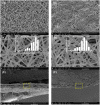Facile Fabrication of Sandwich Structural Membrane With a Hydrogel Nanofibrous Mat as Inner Layer for Wound Dressing Application
- PMID: 30406077
- PMCID: PMC6201043
- DOI: 10.3389/fchem.2018.00490
Facile Fabrication of Sandwich Structural Membrane With a Hydrogel Nanofibrous Mat as Inner Layer for Wound Dressing Application
Abstract
A common problem existing in wound dressing is to integrate the properties of against water erosion while maintaining a high water-uptake capacity. To tackle this issue, we imbedded one layer of hydrogel nanofibrous mat into two hydrophobic nanofibrous mats, thereafter, the sandwich structural membrane (SSM) was obtained. Particularly, SSM is composed of three individual nanofibrous layers which were fabricated through sequential electrospinning technology, including two polyurethane/antibacterial agent layers, and one middle gelatin/rutin layer. The obtained SSM is characterized in terms of morphology, component, mechanical, and functional performance. In addition to the satisfactory antibacterial activity against Staphylococcus aureus and Escherichia coli, and antioxidant property upon scavenging DPPH free radicals, the obtained SSM also shows a desirable thermally regulated water vapor transmission rate. More importantly, such SSM can be mechanically stable and keep its intact morphology without appearance damage while showing a high water-absorption ratio. Therefore, the prepared sandwich structural membrane with hydrogel nanofibrous mat as inner layer can be expected as a novel wound dressing.
Keywords: antibacterial activity; antioxidant activity; hydrogel nanofibrous mat; sandwich structure; wound dressing application.
Figures









Similar articles
-
Wound dressing based on electrospun PVA/chitosan/starch nanofibrous mats: Fabrication, antibacterial and cytocompatibility evaluation and in vitro healing assay.Int J Biol Macromol. 2019 Feb 1;122:238-254. doi: 10.1016/j.ijbiomac.2018.10.115. Epub 2018 Oct 18. Int J Biol Macromol. 2019. PMID: 30342125
-
Novel bilayer wound dressing based on electrospun gelatin/keratin nanofibrous mats for skin wound repair.Mater Sci Eng C Mater Biol Appl. 2017 Oct 1;79:533-540. doi: 10.1016/j.msec.2017.05.076. Epub 2017 May 14. Mater Sci Eng C Mater Biol Appl. 2017. PMID: 28629050
-
Synthesis, characterization, and antimicrobial properties of novel double layer nanocomposite electrospun fibers for wound dressing applications.Int J Nanomedicine. 2017 Mar 21;12:2205-2213. doi: 10.2147/IJN.S123417. eCollection 2017. Int J Nanomedicine. 2017. PMID: 28356737 Free PMC article.
-
Curcumin-loaded sandwich-like nanofibrous membrane prepared by electrospinning technology as wound dressing for accelerate wound healing.Mater Sci Eng C Mater Biol Appl. 2021 Aug;127:112245. doi: 10.1016/j.msec.2021.112245. Epub 2021 Jun 10. Mater Sci Eng C Mater Biol Appl. 2021. PMID: 34225884
-
An Overview on Application of Natural Substances Incorporated with Electrospun Nanofibrous Scaffolds to Development of Innovative Wound Dressings.Mini Rev Med Chem. 2018 Feb 14;18(5):414-427. doi: 10.2174/1389557517666170308112147. Mini Rev Med Chem. 2018. PMID: 28271816 Review.
Cited by
-
Gallic Acid-Loaded Sodium Alginate-Based (Polyvinyl Alcohol-Co-Acrylic Acid) Hydrogel Membranes for Cutaneous Wound Healing: Synthesis and Characterization.Molecules. 2022 Dec 1;27(23):8397. doi: 10.3390/molecules27238397. Molecules. 2022. PMID: 36500491 Free PMC article.
-
Antiviral Nanomaterials for Designing Mixed Matrix Membranes.Membranes (Basel). 2021 Jun 22;11(7):458. doi: 10.3390/membranes11070458. Membranes (Basel). 2021. PMID: 34206245 Free PMC article. Review.
-
Fabrication of Electrospun Polymer Nanofibers with Diverse Morphologies.Molecules. 2019 Feb 26;24(5):834. doi: 10.3390/molecules24050834. Molecules. 2019. PMID: 30813599 Free PMC article. Review.
-
Antibacterial, Flexible, and Conductive Membrane Based on MWCNTs/Ag Coated Electro-Spun PLA Nanofibrous Scaffolds as Wearable Fabric for Body Motion Sensing.Polymers (Basel). 2020 Jan 5;12(1):120. doi: 10.3390/polym12010120. Polymers (Basel). 2020. PMID: 31948041 Free PMC article.
-
Microneedle Array Patch Made of Kangfuxin/Chitosan/Fucoidan Complex Enables Full-Thickness Wound Healing.Front Chem. 2022 Jan 26;10:838920. doi: 10.3389/fchem.2022.838920. eCollection 2022. Front Chem. 2022. PMID: 35155371 Free PMC article.
References
-
- Ahmed F. E., Lalia B. S., Hashaikeh R. (2015). A review on electrospinning for membrane fabrication: challenges and applications. Desalination 356, 15–30. 10.1016/j.desal.2014.09 - DOI
-
- Chen G., Chen J., Yang B., Li L., Luo X., Zhang X., et al. . (2015). Combination of aligned PLGA/Gelatin electrospun sheets, native dental pulp extracellular matrix and treated dentin matrix as substrates for tooth root regeneration. Biomaterials 52, 56–70. 10.1016/j.biomaterials.2015.02.011 - DOI - PubMed
LinkOut - more resources
Full Text Sources

